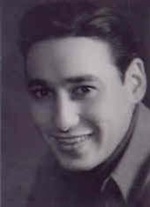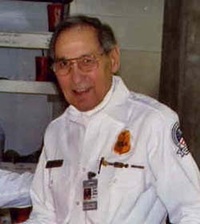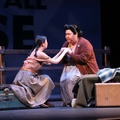Virgil Westdale’s exceptional life story might never have been published had he not attended a Halloween dance. Unsure of what to wear, the World War II veteran donned his Army uniform of the 442nd Regimental Combat Team, nearly sixty years after issue and still a perfect fit. On the dance floor, he met Stephanie Gerdes, who remarked, “it’s not really a costume, is it?” After many more questions spanning two years, the two collaborated on Westdale’s autobiography, Blue Skies and Thunder: Farm Boy, Pilot, Inventor, TSA Officer, and WWII Soldier of the 442nd Regimental Combat Team. Westdale has earned accolades in every occupation listed in the book’s lengthy subtitle through determination, talent, and a strong work ethic. But his career path took an unforeseen turn because of his heritage. Westdale (born Nishimura) is half Japanese.

Virgil Westdale, while serving with the 522nd Field Artillery Battalion in Vosges Mountains, eastern France, October 1944. (Photo courtesy of Japanese American Veterans Association, www.javadc.org)
Virgil Westdale was born in 1918 on a farm in Indiana, the fourth of five children in the Nishimura family. Virgil’s father emigrated from Japan as a 16 year-old orphan, arriving first in Hawaii, moving on to San Francisco in 1906 and then to Denver, where he met and married his American wife of English and German heritage. After the birth of their first daughter, the family moved in with Virgil’s maternal grandparents in Toledo, Ohio and then to their grandmother’s 40-acre farm in Indiana. A good harvest of peppermint brought in enough income for the Nishimura’s down payment on a farm of their own in Michigan when Virgil was nine years old. It wasn’t an easy life and the family did without running water and electricity until long after the children were grown.
Virgil, at 6 feet tall, was by any measure a typical meat-and-potatoes midwestern farm boy. Although an unexceptional student because farm chores took priority over homework, he entered college thanks to an appeal to the registrar of Western Michigan College from his high-school principal. Virgil passed the college entrance exams, enrolling in 1940. In 1941, he saw a notice in the school newspaper advertising a pilot training program for forty dollars. Virgil borrowed money for the course and became a private pilot. Shortly thereafter, the Japanese bombed Pearl Harbor and the U.S. entered the war.
Concerned that his ethnicity would affect his aviation career, “I didn’t ask and I didn’t tell,” said Westdale, recently interviewed from his home in Grand Rapids, Michigan. “I didn’t even know about Executive Order 9066.” So far removed from the West Coast, the order did not affect his family but its aftermath did affect him later on.
Westdale had to make a choice. The War Training Service (WTS) wanted more pilots. Should he join up or stay in college? He decided to quit school and enter the civilian training program for the WTS, becoming a top student in acrobatic flying. Upon graduation, though, a program instructor said, “Virgil, there’s a flight inspector here to see you.” “Why,” Virgil thought, “because I’m a top student?” The inspector was over at the tower. As Virgil crossed the field, he “wondered if I’d ever be flying again.” Mr. Humphrey, the inspector, said, “Virgil, I have to ask for your license. I’m sorry.” Virgil handed his license over without question. That’s the way he was raised, to respect authority. He dreaded having to go back to the terminal but the others already knew all about it. He was out of the program.
Virgil’s license was withheld during a five month long inquiry by the Federal Bureau of Investigation, the Office of Naval Intelligence and the War Relocation Authority. The agencies turned up nothing and eventually reinstated Virgil’s pilot’s license. Hoping to avoid future trouble, Virgil translated his last name from Nishimura (Nishi—west, Mura—village) to its closest English counterpart, Westdale. He joined the Army Air Corp and by October of 1942, once again demonstrated excellence as a pilot. He became a commercial instrument flight instructor and had been teaching cadets for three or four months when he received a notice from the War Department. “By order of the President,” Westdale recalled, he was transferred from the Air Corp to the Army as a private in the 442nd Army Regimental Combat Team, “the lowest you could go,” referring to the rank, private. “It could have destroyed my soul but my background wouldn’t allow that to happen.” He accepted his assignment to the all-Japanese American 442nd Regimental Combat Team.
When Westdale stepped off the bus at Mississippi’s Camp Shelby, he remembers thinking, “my golly, they’re all Asian! They were looking at me, also, wondering ‘who’s this Caucasion guy who is here in our unit?’ The first sergeant of Company F asked me, ‘what can I do for you?’ He thought I was in the wrong outfit.” This was Westdale’s introduction to Japanese Americans. Towering over his fellow soldiers, he was quickly assigned to carry the BAR (Browning Automatic Rifle), a twenty-one pound weapon with tripod. Each platoon was issued only one of these heavy weapons.
Japanese culture was almost completely foreign to Westdale’s rural midwestern upbringing. Other than his father who had been in the United States for over thirty years, he didn’t know any Japanese people. Asian culture wasn’t part of the family’s daily life nor had his mother even mentioned any concerns or conflicts resulting from marrying a Japanese. All Westdale knew, once at Fort Shelby, was that “these guys were sure a lot different. For example, the Hawaiians sure liked to gamble!” He also had trouble getting used to Hawaiian food. But as he became acquainted with his fellow soldiers, Westdale said, “I learned a lot from them. I also knew I would never be left alone while we were fighting the war. It was a good feeling. They were really great guys.”
Westdale’s sister, however, was distraught over the end of her brother’s flying career. She wrote to Mrs. Eleanor Roosevelt, appealing, “isn’t it a shame all this money was spent to train him and now he’s an Army private?” A few weeks later, Westdale received a letter from the War Department transferring him from the infantry to the 522nd Field Artillery Battalion, a significant entity of the 442nd Regimental Combat Team. That duty offered a chance to fly observation planes. It turned out, however, that the Army never did let him fly. “I could have taught those pilots many things about flying,” said Westdale. Instead, he was selected to be in the fire direction center and trained in technical aspects of targeting the enemy as they were spotted.

Westdale on duty at Gerald R. Ford Airport, Grand Rapids, Michigan. (Photo courtesy of Japanese American Veterans Association, www.javadc.org)
Westdale never told anyone in his unit that he was a pilot. He guessed that some knew but he wasn’t the only one with high level yet under utilized skills. Others were mechanical engineers, chemical engineers and a wide variety of professional occupations. The 442nd Regimental Combat Team, composed of these exceptional individuals as they went on to become the most highly decorated regiment in military Armed Forces history.
Army commanders, at first, were skeptical about the fighting prowess of the Japanese American soldiers. Westdale recalled, “General Eisenhower didn’t want Japanese fighters. General Mark Clark said, ‘I’ll take ‘em. General Marshall said let me know how they do.” After the 100th Infantry Unit composed of Japanese Americans from Hawaii fought so valiantly at Salerno, Italy, driving the enemy back despite heavy casualties, they became known by other army units as the Purple Heart Battalion. “From then on,” said Westdale, “they gained a tremendous reputation.” Soon, the 100th joined the 442nd Regimental Team’s three infantry battalions. Westdale’s 522nd Field Artillery Battalion provided support to the infantry, establishing a reputation for expertise in the time firing and accuracy of 105 (105mm Howitzer) artillery weapons.
Westdale believes that the 522nd never received the recognition it deserved citing a battle in Italy as an example. “We were called because the infantry was pinned down at Hill 140,” said Westdale. “We moved quickly, the first time in European history using a proximity fuse 105 shell, and destroyed the hill. One hundred and twenty Germans were killed. It was so bad, the High Command didn’t want the 522nd artillery battalion to roll by that hill. They didn’t want them to see the slaughter.” He continued, “We’re the ones that took care of the hill. The 442nd infantry took the hill but the 522nd didn’t get any credit. We were forgotten.”
Certainly not forgotten, however, was Westdale’s role in the liberation of Jewish prisoners at Dachau. On April 14, he was one of 120 honored as a camp liberator at the 2010 National Tribute Dinner held at the Holocaust Memorial Museum. Two soldiers from Westdale’s unit shot the locks off the compound gates at Dachau in order to release the prisoners. He remembered that the prisoners were afraid because they thought the soldiers were from Japan, working with the feared SS (the Schutzstaffel, identified by an insignia under their forearm of two parallel lightning streaks.) “They didn’t want to come out,” recalled Westdale. “We said ‘we’re American, we’re American, you’re free!’ That day, I went around knocking on doors, looking for food and clothing to give them. I spoke a bit of German. The SS could have been in those houses. They were mean, vicious Hitler elites.”
This was just one dramatic episode detailed in Westdale’s memoir, Blue Skies and Thunder. After the war, Westdale married and had three children. He worked for sixteen years at Burroughs Corporation and twenty-two years for AM International, in the field of printing products and equipment where he developed and patented more than two dozen inventions. After the 2010 publication of Blue Skies and Thunder, two of Westdale’s co-workers contacted him after they each had bought and read the book. Westdale asked them, “Tell me, Jim or Art, did you know anything about me?” Even his own longtime employees never knew about his military service. “Nope, they didn’t even know I was part Japanese. That’s how quiet I became about who I was.”

Mr. Westdale receives Employee of the Year Award on behalf of TSA employees from Administrator Rear Admiral David M. Stone (Ret). (Photo courtesy of Japanese American Veterans Association, www.javadc.org)
Westdale, now divorced, retired in 1988 before starting a new career in 1995, at the age of 77, in airport security. For more than fourteen years, he worked at Globe Aviation Security and the Transportation Security Administration (TSA). In 2005, he received TSA’s Employees of the Year award on behalf of all the TSA employees, and in 2008, he received a U.S. Senate Certificate of Congressional Recognition. While at Globe, one of the airport’s police officers became curious about his background and in 1995 began to ask him questions about his life and military service. Reluctantly, Westdale revealed snippets of information over the course of seven years. Often, the memories were upsetting. “At the time, it’s kill or be killed,” said Westdale, “but it affects you later on in life. Sometimes, I’d have to step away to collect myself.” His TSA co-workers kept telling him that he had to write a book. It is because these events were so vividly etched in his mind and had evoked such interest that Westdale finally decided to write his memoir along with co-author Stephanie Gerdes. He had experienced so much that should never be forgotten. Several years ago, when TSA co-workers were discussing television news reports about the spread of rumors denying the Holocaust, Westdale had this to say. “If anyone tells you the Holocaust never happened, it did. I was there.”
* * *
The Japanese American Museum will host authors Virgil Westdale and Stephanie Gerdes for a program at 2:00 pm on Sunday, September 26, 2010. A book signing for Blue Skies and Thunder will follow the program.
© 2010 Japanese American National Museum








